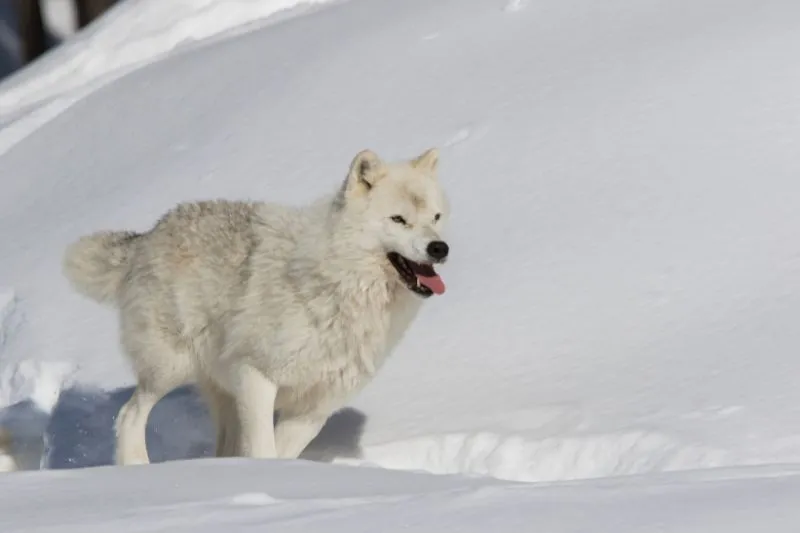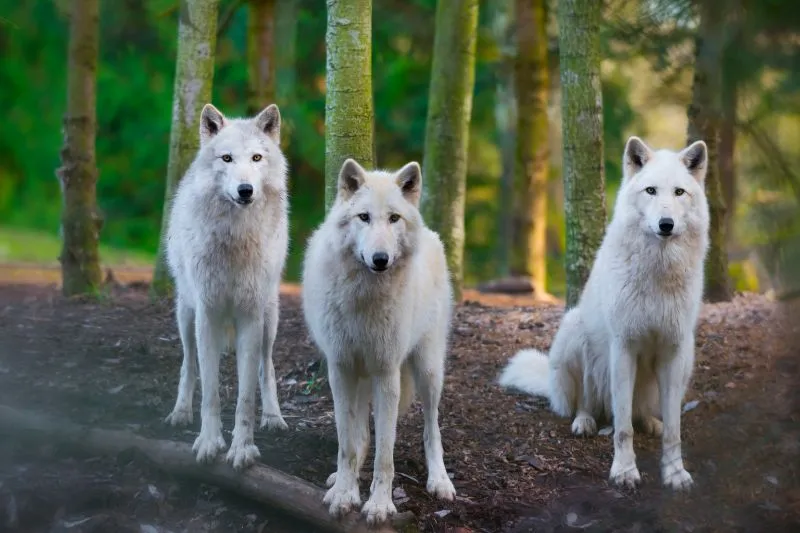What we know of arctic wolf behavior is largely based on the stories of chance encounters as told by researchers, ecotourists, and explorers in the Arctic. What are these interactions like? Are arctic wolves dangerous?
Arctic wolves live in isolated, high Arctic regions so they rarely come into contact with humans and have little to no fear of us. Arctic wolves are likely to be curious, inquisitive, and sometimes, even playful with humans. Arctic wolves are not dangerous with very few recorded attacks on humans, however, conflict can arise due to rabies (which makes them aggressive) or through misinterpretation of their curiosity.
Read on to learn more about arctic wolves’ curious behavior and whether or not they can be tamed and kept as pets…
Are Arctic Wolves Dangerous to Humans?
Arctic wolf attacks on humans are extremely rare.
Arctic wolves inhabit some of the most isolated regions of the globe. They live in high arctic regions far from human communities. As such, they rarely come into contact with any humans and behave very curiously compared to wolves that live near urbanized areas such as the North American Gray wolf.
Due to frequent contact with humans, there is a fear instilled in Gray wolves that often results in conflict with humans. This fear is absent or reduced in the arctic wolves.
In the presence of humans, the arctic wolves have a certain swagger and confidence. They often approach people with little to no apprehension and lots of curiosity.
According to one polar scientist living on Ellesmere Island, if you stay calm, the wolves can come right up to you. Apparently, they want to understand (with little malice), who you are, what you are, and why you are on their land1 (source: Snow Wolf Family and Me, BBC Two TV Show).

Can Arctic Wolves Be Pets?
Arctic wolves are seen as an ‘exotic pet’ and as such, their breeding and trade fall into the controversial and lucrative exotic pet trade.
There are no US-wide laws put in place regarding keeping arctic wolves as pets. However, some states have introduced laws and regulations to ban this.
Below are the state-by-state laws on whether you can keep an arctic wolf (or any other wolf) as a pet:
| US State | Can a wolf be kept as a pet? | US State | Can a wolf be kept as a pet? |
| Alabama | Yes | Michigan | No |
| Alaska | No | Minnesota | No |
| Arizona | Yes, with restrictions. | Mississippi | Yes, with a permit. |
| Arkansas | Yes, with restrictions. | Missouri | Yes, with restrictions. |
| California | No | Montana | Yes, with restrictions. |
| Colorado | No | Nebraska | No |
| Connecticut | No | Nevada | Yes |
| Delaware | Yes, with restrictions. | New Hampshire | No |
| Florida | Yes, with a permit. | New Jersey | No |
| Georgia | No | New Mexico | No |
| Hawaii | No | New York | No |
| Idaho | No | North Carolina | Yes, with restrictions. |
| Illinois | No | North Dakota | Yes, with restrictions. |
| Indiana | Yes, with restrictions. | Ohio | No, but allowed wolf hybrids. |
| Iowa | No | Oklahoma | Yes, with a permit. |
| Kansas | No | Oregon | No |
| Kentucky | No | Pennsylvania | Yes, with a permit. |
| Louisiana | No | Rhode Island | Yes, with a permit. |
| Maine | Yes, with a permit. | South Carolina | No |
| Maryland | No | South Dakota | Yes, with a permit. |
| Massachusetts | No, but allowed wolf hybrids. | Tennessee | No |
| Texas | Yes | Washington | No |
| Utah | No | West Virginia | No |
| Vermont | No | Wisconsin | Yes, with a permit. |
| Virginia | No | Wyoming | Yes |
In summary, many states have made it illegal to keep arctic wolves as pets including California, New York, and Washington. In states, where this is legal, there are usually specific licenses required to ensure the safety of the wolf, the owners, and the wider community.
Interestingly, in the UK is it legal to own a hybrid of a wolf as long as they are three generations away from the ancestral wolf and a license has been attained in accordance with the Dangerous Wild Animal Act 1976 (source: UK Government).
Numerous wildlife charities are against the ownership of wolves. They argue that wolves, whilst genetically similar, are vastly different in terms of behavior, from domesticated dogs. Dogs have been socialized by humans for over 10,000 years. As such, pet wolves have vastly dissimilar needs2 (source: R. Lenkei, et al, Scientific Reports, Vol. 10, Article No: 17296, 2020).
- Space: Artic wolves need a massive area to roam around in. In their natural habitats, their territories can surpass 1,000 km2 3(source: Wolf.org). We cannot even begin to replicate this in a captive environment.
ㅤ - Diet: Wolves are active hunters and cannot eat dog food. They need raw meat, bones, organs, and even fur to contribute to their complete nutrition.
ㅤ - Sociality and intelligence: Arctic wolves are highly social beings living in tightly knit packs. We cannot provide a social structure reflective of what they have in the wild.
Can Arctic Wolves Be Tamed?
There have been a few cases where wolves, that have been raised by humans, develop social bonds with their owners.
Taming a wolf requires intense early socialization and hand-rearing from their human handler to form an attachment sustained into adulthood. It is believed that wolves can integrate into human groups due to their social, multi-unit, pack structure.
Yet, wolves can still be unpredictable and turn on their owner, upon reaching sexual maturity4 (source: R. Lenkei, et al, Scientific Reports, Vol. 10, Article No: 17296, 2020).
Are Arctic Wolves Friendly?
Yes, arctic wolves can be friendly towards humans and are often inquisitive and playful. Here are some recorded friendly interactions with arctic wolves recorded over the years:
- The Dance-Off: A scientist and their colleague, were living on Ellesmere Island and spotted two young arctic wolves nearby. The two colleagues decided to wrestle each other so that the wolves might feel comfortable in their presence. And, amazingly, the arctic wolves responded to this by tumbling about themselves and chasing each other. They would pause every so often to wait to see what the humans would do next, and so ensued, a dance-off (of sorts)5(source: Snow Wolf Family and Me, BBC Two TV Show).
ㅤ - Playing fetch: Another researcher living on Ellesmere Island was able to play fetch with a pack of arctic wolves 6(source: Snow Wolf Family and Me, BBC Two TV Show).
However, every arctic wolf is different. One may be more cautious, one may not care about humans, whilst others may feel threatened by human presence and could cause injury. Therefore, one should always maintain a degree of caution when encountering arctic wolves, even if past stories suggest they have a friendly side.

Are Arctic Wolves Aggressive?
No, arctic wolves are not typically aggressive. According to a study, just 0.6% of arctic wolf encounters could be categorized as aggressive. Generally, arctic wolves are less aggressive than their close relative, the North American Gray wolf7 (source: U. Marquard-Petersen, Arctic, Vol. 75, No. 3, 2022, pp.378-389).
Aggressive or not, mankind has longstanding negative connotations with wolves as evidenced by their bad reputation across numerous cultures’ histories and literature. When encountering a wolf, we are predisposed to interpret their behavior as aggressive.
For example, an arctic wolf briskly walking towards someone is a sign of curiosity that is often mistaken for something more sinister. Misinterpretation has led to instances where arctic wolves have been shot down. In Northern Greenland, an arctic wolf was shot by tourists after the wolf closely approached them8 (source: U. Marquard-Petersen, Arctic, Vol. 75, No. 3, 2022, pp.378-389).
Whilst aggressive arctic wolf encounters can be misinterpreted, they have still occurred on a few occasions…
- An arctic wolf bit a researcher on the 1913-1919 Canadian Arctic Expedition. Reports are unclear whether the wolf was provoked, rabid, or neither9 (source: S.E. Jenness, The Arctic Institute of North America, 1985).
ㅤ - In Ellesmere Island, 1977, an arctic wolf leaped at a researcher leaving saliva on her face. No harm came to her, but it could be interpreted as aggressive behavior from the wolf10 (source: K. Munthe and J.H Hutchison, Journal of Mammalogy, Vol 59, Issue 4, 1978, pp.876–878).
Rabies is often a contributing factor that can be the cause of wolf attacks. In these cases, it is less about the personality of arctic wolves and more about the onset of disease that enhances aggression11(source: Snow Wolf Family and Me, BBC Two TV Show).
Do Arctic Wolves Eat Humans?
No, there have been no recorded instances of arctic wolves eating humans.
Arctic wolves are carnivores, they mostly eat arctic hares, caribou, and muskoxen found in the arctic tundra12 (source: L.D. Mech, Arctic, Vol. 60, No. 3, 2007, pp. 309-311).



![Read more about the article How Many Arctic Wolves Are Left? Are They Endangered? [2023]](https://polarguidebook.com/wp-content/uploads/2023/06/Untitled-design-9-300x200.png)

